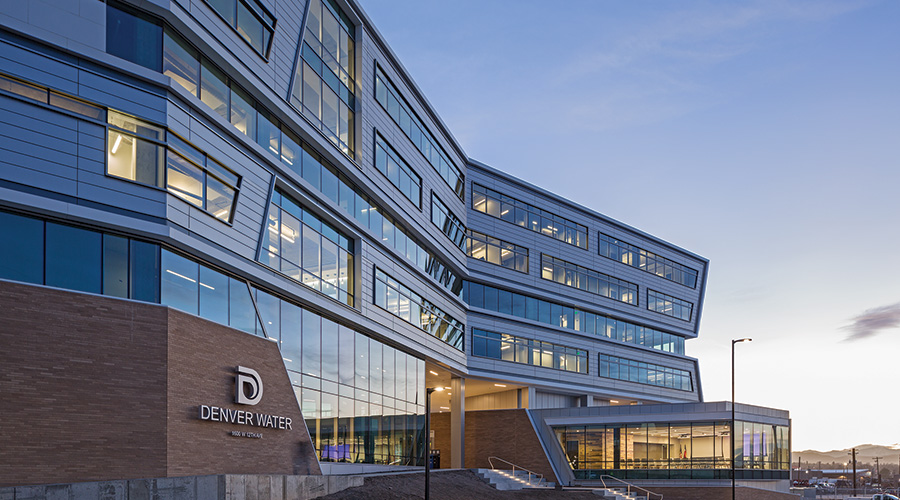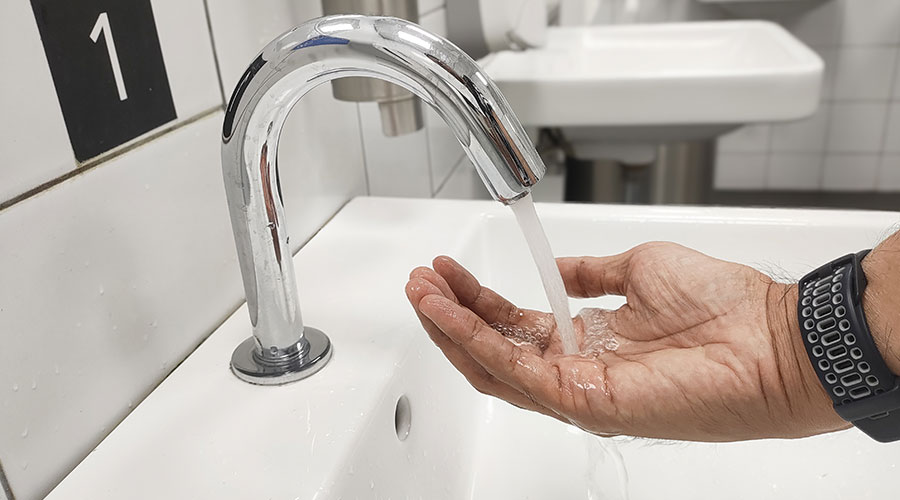Attractive and Efficient: A Look at Contemporary Restroom Design
When Silviu Gavriliuc, operations manager with the Gwinnett Environmental & Heritage Center, first learned that the urinals in the two men’s restrooms at the Center would use no water, he admits he was a bit skeptical. “My concern was maintenance,” Gavriliuc says. He wondered just how difficult it would be to keep the urinals clean and odor-free.
Gavriliuc’s hesitation about new technology isn’t uncommon among facility executives. Nor is it surprising. A new technology — one that a facility executive has no experience with — represents a risk. And given the long lives of many building components, and the costs of replacing them, a new technology that doesn’t perform as expected will haunt facility executives for years to come.
Unfortunately, caution can lead to the opposite problem: Facility executives balk at installing newer technologies that have established solid track records. Sometimes, there’s also resistance to using familiar products in new applications. When it comes to restroom products, that means facilities lose out on cost savings and performance benefits of innovative products that have proven themselves.
Gavriliuc’s worries were unfounded. “Maintenance and repair time is about zero,” Gavriliuc says. “And it’s a very hygienic, odor-free restroom.” What’s more, the urinals have saved the Center, located in Buford, Ga., tens of thousands of gallons of water.
Zero-water-consumption urinals are only one example of the innovative restroom products that have come onto the market and gained acceptance in the past few years.
These innovations can help facility executives address a range of issues. Water conservation is perhaps at the top of the list. “Drinking water is a pretty refined, expensive product,” says Jim Nicolow, principal with Lord, Aeck & Sargent Architecture, the firm that designed the Gwinnett Center.
At the same time, there’s also an increased focus on the restroom environment. “There’s very much an emphasis on upgrading the perception of the restroom,” says Mark Duckett, studio director with Kling Stubbins. For example, some facility executives are replacing standard metal stall partitions with wood or drywall separators that extend from the floor to the ceiling, or installing new counter materials that give the appearance of stone or other costly materials. These changes can boost restroom aesthetics for a relatively minor cost.
For facility executives willing to investigate the current generation of restroom product and design options, a renovation presents an opportunity to make significant improvements over the existing restroom. The result can be lower operating costs, a more attractive appearance and more satisfied building occupants.
A Water Audit
Before starting a restroom renovation, a water audit can help determine the amount of water the restroom and other areas of a facility are using, says Amy Vickers, of Amy Vickers & Associates. The auditor breaks water consumption down by various end uses, including restrooms, HVAC equipment, kitchen and laundry facilities, and irrigation.
Most audits are an inexact science, says Tom Breu, lead plumbing engineer with Marshall Erdman & Associates. That’s because it’s not always clear just how much water some devices use. Lavatory faucets, for example, aren’t used for set periods of time. Instead, the auditor might count the number of fixtures. According to current regulations, these should flow at no more than 2.2 gallons per minute (GPM). By counting the number of faucets, estimating how often each is used, and multiplying by 2.2 GPM, the auditor can arrive at an estimate of the water used.
Most audits reveal that the occupants of a facility use far more water than is actually needed, Vickers says. Restrooms aren’t the only culprit, of course. Heating and cooling equipment, as well as lawn irrigation systems, often are water hogs. However, restrooms certainly are part of the mix.
According to the Energy Policy Act of 1992, modern toilets should use no more than 1.6 gallons per flush; previously, most toilets used between 3 and 5 gallons. While many of the water-saving toilets introduced when the Energy Policy Act of 1992 went into effect used less water, they also prompted complaints from users who said they didn’t work very well. Manufacturers were just learning how to make products that met the new requirements. The early low-flow toilets, for instance, simply came with smaller tanks, says Breu. While they complied with the regulation, the toilets didn’t do a good job of removing waste.
In contrast, today’s low-flow toilets outperform even the 3.5-gallon toilets of a decade ago, due to improved design and mechanisms, Breu says. For example, pressure-assist toilets use air pressure within the tank to push out the water, resulting in a heftier flow of water, even though less is actually used. “It’s not just the gravity of the water that pushes out the waste, but the line is charged, so the flush is more robust,” Breu says.
Another option is dual-flush toilets. The lower-flow option typically uses 1.1 gallons of water, which is sufficient to remove liquid waste. The higher-flow option uses 1.6 gallons of water to flush away solid waste. Installing dual-flush valves is a straightforward procedure, and can even be accommodated once a renovation project is underway, because the plumbing is the same as with conventional toilets, Nicolow says.
However, some user education often is required, says Laurie Gilmer, senior project manager with Facility Engineering Associates. Many dual-flush toilets require users to pull the handle up to get the half-flush. If they don’t realize this, most users will push the lever down, resulting in a full flush.
Also, occupants who have experience only with the earlier models of low-flow toilets may be skeptical of claims that the newer models really work as well as they claim. Here again, information and education — actual demonstrations often are most effective — can help change misperceptions.
As Gavriliuc’s experience shows, waterless urinals also are an option in men’s restrooms. Not only do these save water, but if they’re installed during new construction, they can result in cost savings. That’s because they don’t require a water supply line, Nicolow says. On remodeling projects, the existing water supply line can be capped.
Waterless urinals work by passing waste through a cartridge that acts as a sealant designed to prevent odor from escaping back to the restroom. Maintenance employees replace the cartridge every few months, a process that takes less than a minute. The fixture should be sprayed with water and wiped off about once a day.
Facility executives can also consider urinals that use only a pint of water per flush. These use less water than standard urinals but don’t require a cartridge. They do require two water lines.
The more daring facility executives can look into composting toilets. While these traditionally have been used only in places like national parks, Nicolow’s firm has installed one in an office building. A pipe uses water and biodegradable soap to convey the waste to a large bin with a settling chamber, where liquid and solid waste are separated. A bacterial substance breaks down the solid waste, turning it into compost soil.
Admittedly, these aren’t going to hit the mainstream any time soon. For starters, the six-by-eight-foot bins take up quite a bit of space. Perhaps more significantly, there’s the “ick” factor, Nicolow says. “We have a sort of cultural aversion to a box in a building collecting waste.”
With toilets, the flow rate of the valve should match that of the fixture, says Gilmer. Installing a 1.6 gallon per flush valve on a toilets designed for a larger flow could lead to problems with clogging.
With faucets, flow restrictors can be installed on the outlet. Depending on how the system is designed, the lower flow rate may mean it takes longer to get hot water.
Although some government bodies are trying to encourage facilities to save water, support often isn’t in the form of monetary incentives. Instead, more cities and utilities offer free technical assistance or seminars on saving water, Vickers says. “These actually can be more influential than rebates, because there’s some skepticism among facility managers about the low-flow fixtures,” she says.
Aesthetic Motivations
Saving water isn’t the only reason facility executives are upgrading restrooms. Improving the aesthetics of a restroom is also an important reason for an upgrade. While a restroom remodel typically lacks the “wow” factor that a lobby renovation may provide, it still gets noticed, Gilmer says. “When you upgrade a restroom, building occupants love it.”
Moreover, if a lobby is redone, but the restrooms remain shabby and outdated, with flickering lights, balky sink drains and wobbly stall partitions, some occupants may wonder just how well the building is maintained. “If you have a great front-door image, but the restroom dates back to the 1970s, people will wonder if you ran out of money,” says Margo Komplin, interior design services manager with Marshall Erdman.
Facility executives can use relatively inexpensive materials and fixtures to get away from an institutional look, Komplin adds. For example, a wood frame mirror rather than stainless steel gives a warmer look without breaking the budget. Similarly, pendant lighting is a budget-minded way to enhance the ambiance.
Sinks with an under-counter mount, rather than ones that are caulked to a laminate counter, are less likely to trap dirt and debris and collect water. Touchfree faucets and soap dispensers can alleviate users’ concerns about hygiene.
When it comes to counter materials, the number of options is growing quickly, says Jennifer Nye, interior project designer with Kling Stubbins. Examples include recycled glass and concrete that has the look of granite, as well as composite materials made from scrap aluminum and resins.
One trend in restroom design is the use of larger floor or wall tiles, says Komplin. Reducing the amount of grout makes maintenance easier. Smaller tiles are used as accent pieces.
Mounting toilets, counters, and waste cans on the wall, rather than the floor, also helps with maintenance, as cleaning crews can simply clean underneath the fixtures. With floor-mounted fixtures, it’s easier for grime to collect at the connection between the fixture and the floor. However, Breu says that he hasn’t seen any studies showing that wall-mounted toilets actually lead to more sanitary restrooms.
However, before deciding on wall-mounted toilets, facility executives should be aware that some have snapped from the walls when used by extremely heavy people. And they’re more expensive. A recent price list shows wall-mounted toilets running about 50 percent more than floor-mounted ones, Breu says.
And, because the plumbing resides in the wall behind the toilet, rather than under the floor, a thicker wall is needed. The walls also need to be strong enough to bear the weight of the toilet, which is mounted on a carrier, says Gilmer. As a result, this isn’t an easy or quick switch to make.
Some facility executives install wall-mounted toilets on both sides of a wall — a men’s restroom on one side and a women’s on the other, for example. Then, they make the area in between large enough that a maintenance worker can walk in to access the plumbing.
Project Management
In most renovation projects, a restroom upgrade is part of a larger remodel and doesn’t drive the overall schedule, says Breu. However, facility executives still should talk with the contractor, and make sure the goals of the project are clear, says Duckett.
Facility executives also should compile a wish list and test the budget against the current market, Komplin says. Doing so can avoid surprises in labor costs.
Before starting, it pays to spend extra time inspecting the facility, especially if the building’s schematics are not up to date, says Jack Donahue, process and plumbing design supervisor with Kling Stubbins. That’s often the case with buildings that have undergone several renovations or additions. It’s not uncommon for workers to find abandoned pipes or electrical systems. Before work begins, workers should find out if they’re live and need to be topped off.
While restroom upgrades have become bigger projects, they also have become marketing tools, and often can result in an attractive return on investment within commercial facilities. “It used to be that the sizzle in the restrooms was the province of hospitality facilities,” says Duckett. Today, organizations of all types want that sizzle.
Karen Kroll, a contributing editor for Building Operating Management, is a freelance writer who has written extensively about real estate and facility issues.
Related Topics:











